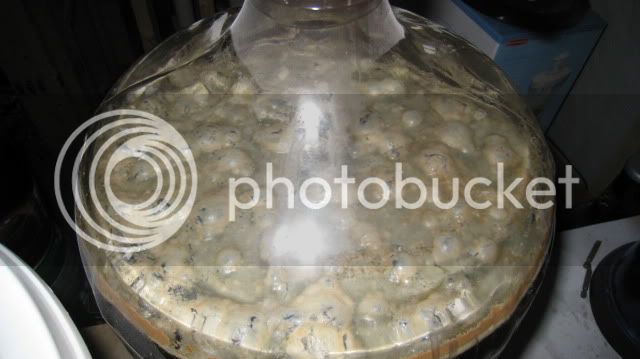ohiobrewtus
Well-Known Member
That's it, fool...consider yourself jacked:







From Brian Perkey himself.
cool. I wish they would list somewhere what is in the blend (like they do for 3278). Do you have any insight into this?

I'm not sure this is true. I bought a propagator pack of the 3278 Lambic blend a couple weeks ago. I doubt Wyeast would offer a lambic blend in a propagator pack if it would mess up the ratios of organisms.












Came here looking for progress reports, but you're probably doing your best to just let this one sit. Finally pitch my Roeselare last night. Smack pack didn't swell much and I hung onto it for longer than planned, so I'm a little nervous about its viability. I'll be keeping my fingers crossed and following yours here to see what to expect. Looking forward to any updates.
Thanks for the writeup, pitched a barely swolen pack of roeselare into a fairly high gravity flanders brown sunday around noon. Trying not to worry 35 hours into it, not even a blip on the top of the liquid. Your description of a slow starter has me still hopeful.
I know, I have read the 72 hour stickybut none of my 25-odd batches have taken this long

Also went the Flanders Brown route with my Roeselare. Starting gravity was a lot lower (1.064), but it did take three days to start. Be interested to hear your results and if you do a second pitch.It ended up around 1.088. I followed (for the most part) the recipe from Brewing Classic Styles Flanders Brown.
That sounds like the beginning of a pellicle to me... isn't that what you were looking for?
how much oak cube did you end up adding or did you soley go with the oak peg? And how was the Biere de Mars. I had been wanting to try that so now im curious
You think there is enough viability in these to make a noticeable effect? We are doing a small Flanders Red tasting in a month or so with I believe ten examples of the style. Since no one else attending has a Flanders Red in the works I called dibs on the dregs from all the bottles. I figure I will put them all in one bottle, cap it, then go home and dump them in the barrel. But the more I think about it I'm wondering if the bugs in there really stand a chance against the already established critters from the multiple Roeselare packs I pitched. You think it's worth the trouble?To add some deeper complexity to my Flanders Red, I just added the dregs from bottles of both Rodenbach Grand Cru and Ommegang's Biere de Mars to the secondary.
You think there is enough viability in these to make a noticeable effect? We are doing a small Flanders Red tasting in a month or so with I believe ten examples of the style.
I am most excited because we have a bottle of Rodenbach Vin de Cereale, and if those bugs are still alive and can take hold inside my barrel I would be ecstatic.
Oldsock's comment early in this thread suggests it has been successful for him in the past!
All the info I've read suggests that Rodenbach is filtered:
Rodenbach Grand Cru
Brew Your Own: The How-To Homebrew Beer Magazine - Beer Styles - Oud Bruin: Style of the Month
The bottle I had a month ago was pretty clear all the way to the bottom without any notice of dregs.
Oldsock's comment early in this thread suggests it has been successful for him in the past!
All the info I've read suggests that Rodenbach is filtered:
Rodenbach Grand Cru
Brew Your Own: The How-To Homebrew Beer Magazine - Beer Styles - Oud Bruin: Style of the Month
The bottle I had a month ago was pretty clear all the way to the bottom without any notice of dregs.
Yup, duchesse is filtered as well, even the large bottles